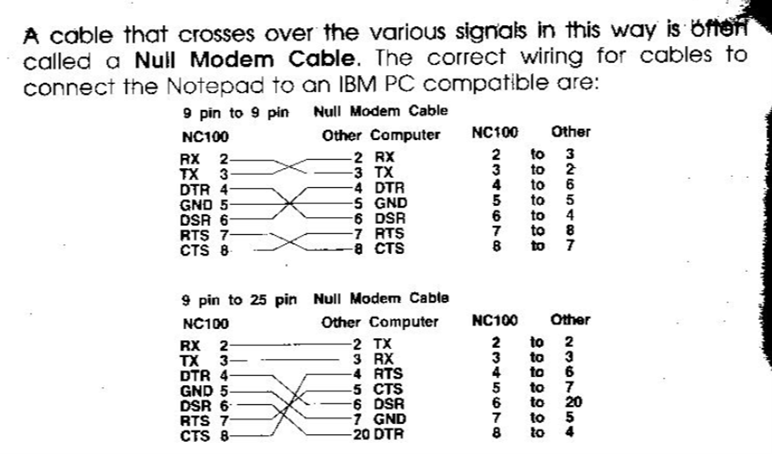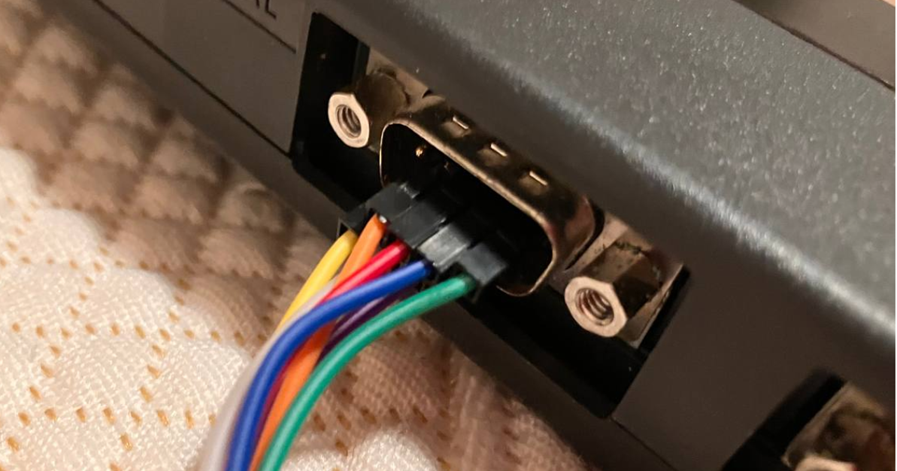Connecting to the BBS via Amstrad NC100 from 1992

The Amstrad NC100 was quite unique for its time. At just £199, the laptop was truly mainstream and capable. Many people tried programming on it for the first time, while others used it as an electronic typewriter that allowed them to work on the road. The saved text could later be printed on a printer.
If you look at the available ports on the NC100, it becomes really sad. There are no newfangled things like network cards provided here. There is also no built-in modem. Of course, you could try to connect a real external modem, but finding a live Dialup provider is almost impossible.
Of course, it would be possible to connect two modems and connect computers in this way, but this is already overkill. It is much easier to use a very old, but perfectly working feature – a direct connection using a so-called null modem cable.
Technology of the Ancients
There is a reason why the COM port is called that. It is great for communication not only with peripheral devices, but also for connecting a pair of computers with each other. For connection, use a cable or adapter RS232 DB9F/F. Theoretically, the maximum speed of such a connection can reach 115 Kbps, but the NC100 only supports 9,600 bps. When purchasing, be sure to pay attention to the pinout:

Of course, it is no longer possible to find such a cable in a regular store. But there is no problem ordering it on eBay or Amazon. My copy is still on the way, so I used the simplest option – connecting wires with female-to-female connectors. The option is not the most convenient, but it works:

On the other side we connect to the COM port, observing the pinout above. You can no longer find COM ports on modern computers, but there are quite convenient USB-to-COM adapters on sale. In order not to touch the main operating system of the computer, we will use Oracle VirtualBox and create a virtual machine based on Ubuntu 22.04 LTS.
Terminal application
In the virtual machine settings we will specify COM port forwarding. After downloading, our adapter will have a name /dev/ttyS0. Alternatively, you can forward not the COM port, but the USB device itself. In this case, Ubuntu itself will deal with the driver and display the new device as /dev/ttyUSB0.
On Amstrad NC100 press the key combination Function+Sand then press the key Secret Menuto open hidden settings. Let's check that Baud rate set to value 9 600, and if this is not the case, then change the parameter using the arrow keys. Return to the application using the key Stop.
By default, tty is not output to the serial port, so nothing is displayed on the screen of the terminal application yet. To fix this, you can use an application like agetty. The meaning here lies in the name itself: an alternative client for gaining access to a tty device. If this program is not present by default, then it can be installed in the standard way via apt:
$ sudo apt -y install agettyNow we launch agetty, pointing to the COM port and setting its speed:
$ sudo agetty /dev/ttyS0 9600
Great, now you can use the Amstrad NC100 as a full-fledged terminal emulator. This, by the way, also works great for controlling single-board computers like Raspberry Pi or network devices that support console cables, for example, Cisco.
The problem is in the display – the lack of backlight makes work uncomfortable, and due to the small number of lines, not all information fits on the screen. When using the COM port, the computer eats batteries like a child eats candy. So stock up on batteries or use an external power supply.
Let's go online
Having played enough with the terminal, we decided to think about something more interesting: is it possible to access the Internet on such a device? The answer is both positive and negative. Of course, we’re not even talking about any TCP/IP stack here, let alone a browser. But to connect to the BBS, this was not required. We already talked about how you can create your own BBS on Raspberry Pi, and briefly mentioned BBSs that are still available via IP. But how to connect to them from a device that does not have this protocol?
This is where the app comes to the rescue. tcpser. It emulates an AT command (Hayes compatible) modem that uses TCP/IP for incoming and outgoing connections. This program acts as the very layer that takes a domain name instead of a phone number and returns data as if you were actually connecting to a modem on the other side. Install:
$ sudo apt -y install tcpserNow let's run:
$ sudo tcpser -d /dev/ttyS0 -s 9600This is how a virtual machine turns… a virtual machine turns… into a gateway for accessing the BBS. On Amstrad NC100 we type:
ATDT<доменное_имя_BBS_сервера>:<порт_BBS_сервера>Note that there are no spaces between the ATDT and the address. Confirm by pressing Enter and connect successfully. For example, we looked at a live BBS in the state of Texas and went into messages. You can see that someone went there with an Atari 600XL to test the connection at 1200 bps:

Of course, nothing prevents you from attaching some kind of LoRa transmitter to such a computer as a modem and using it as a messenger that will work even if the usual means of communication are unavailable. But on the other hand, any microcontroller with a keyboard and screen will do just as well.
Instead of a conclusion
It's funny, but there are modern devices in the same form factor. So, for example, a company Freewrite created a whole line of electronic typewriters, and their model Alpha It really gives me a feeling of déjà vu. To be honest, after a long conversation with the Amstrad NC100, I wanted to take only the body from it and replace all the filling with a more modern one.
The basis of such a project could be Raspberry Pi Zero, the potential screen could be e-Ink, and instead of a native keyboard, you could develop some custom version using mechanical switches from Cherry or Kailh. Such a computer would be quite energy efficient and modern, while maintaining the spirit of the good old Amstrad.
What do you think, is it worth starting such a project? We are waiting for you in the comments.





